I think custom kitchen cabinets are a great investment—but only if you do it right, the first time. Whether you’re renovating your forever home or boosting your home’s resale value,...

HOW TO REDUCE DRAFTS IN YOUR HOME (8 WAYS)
By Mike Holmes
Mike’s Advice / Home Safety & Maintenance
Friday, January 29th, 2021 @ 1:00am
The average home loses about 30 percent of its heat due to drafts. Drafts can usually be felt around windows, doors and fireplaces, or sometimes homeowners feel cold spots along walls or floors.
Do you have a drafty house? Here are my tips for preventing heat loss and eliminating drafts in your home.
1) DOORS AND WINDOWS: RE-APPLY CAULKING
Replace and reapply any caulking around windows and doors that are missing or dry and cracked. You should inspect the exterior and interior window and doorframes every year.
The best outdoor caulking is rubberized because it lasts longer. It’s also flexible, so it moves with the natural expansion and contraction of the house.
HOW TO TELL IF YOUR WINDOWS ARE DRAFTY:
Here’s a simple way. Hold up a candle near the window and see if it flickers.
2) REPLACE WEATHERSTRIPPING
The seal and weather stripping on doors and windows should also be replaced. This helps stop cold drafts from coming in. Any wide cracks and gaps over a half-inch should also be filled with expanding spray foam, like SikaBoom®.

SikaBoom® has special low expanding foams that fill gaps around windows and doors without putting too much pressure on the window frame.
MY TIP:
Installing weatherstripping around doors and windows is an easy job for most DIY homeowners. Weatherstripping comes with a seal adhesive backing.
The only important thing to remember is to measure all your door and windows so you have sufficient weatherstripping to complete the job.
3) INSTALL DOOR SWEEPS
A door sweep can be added to the bottom of the door (the back of the door, with a door pushing in) and should be flush with the bevel of the threshold of the door.
The sweep brush should not drag along the floor.
4) INSTALL WINDOW FILM
Adding window film will only help on single pane windows and it’s a temporary solution while you save up for new windows.
Also, it can only be used on old windows and to be effective needs to be properly installed with a continuous smooth seal using double-sided tape so the air is effectively trapped.
The idea is that the air trapped between the window and the plastic adds an insulating layer, similar to an extra pane of glass.
RELATED
5) INSTALL INSULATED WINDOW TREATMENTS
Consider installing insulated window treatments, like insulated draperies, layered curtains, cellular or roman shades. Either alone or in combination, these window treatment options will help keep warm air from escaping around windows, plus they can add an effective décor element to any room.
Insulated drapes work best when they are closed so if you enjoy the natural light, use a combination of cellular shades and drapery to get the best results.
RELATED
6) SEAL RECESSED LIGHTS OR POT LIGHTS
When recessed lights or pot lights are installed on the top floor of a home, holes will need to be cut into the ceiling, which means creating a penetration into the attic space.
A home’s attic is a cold zone – the temperature in the attic should be the same as the air outside. If there isn’t enough insulation around the pot light heat will escape into the attic.
It’s important to make sure there is vapour barrier in the attic, properly tuck taped to seal around the pot light to the original vapour barrier that was cut. And they must be the right kind of pot light for an insulated space-IC lights.
RELATED
Drafts and air leaks can account for up to 30% of your home’s heat loss. Take a walk around the exterior of your home…
Posted by Mike Holmes on Tuesday, September 11, 2018
7) SEAL BASEMENTS
Basements and crawlspaces can also be a source for drafts and air leakage.
Sealing cracks and holes can help prevent cold floors and reduce drafts. Using expandable spray foam, like SikaBoom®, a low-expansion, polyurethane foam will help weather seal and insulate around basement windows and doors.
I like this because it prevents bowing and warping of window frames and doors and can even be used as a pest blocker.
Use a silicone caulk to seal cracks and openings in basement walls, including openings around gas, dryer vents, water, electrical lines, ducts and wiring that pass to the exterior wall of the home.
If you have an unfinished basement, or are about to undertake a renovation, this is a perfect opportunity for you to easily find and address all the draft points and to look for any evidence of moisture.
You want to make sure your basement is free of air leaks and moisture before spending lots of money on a finished basement.

Photo of Holmes Approved Homes builder Colpitts
RELATED
8) ENSURE ELECTRICAL BOXES ARE INSULATED
There should also be insulation around electrical boxes located on walls that are part of the home’s building envelope. A lot of the time the vapour barrier is poorly done or missing altogether and allows cold air to seep through.
Again, an expandable spray foam, like SikaBoom® will work well here.
When you have a drafty house, you will see it in your monthly energy bills. Trust me.
SIGN UP
FOR MY NEWSLETTER FOR MORE TIPS ON HOW TO MAINTAIN YOUR HOME.
READ NEXT









